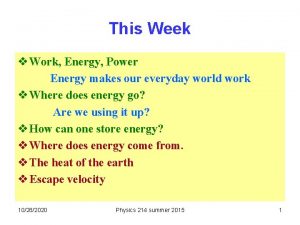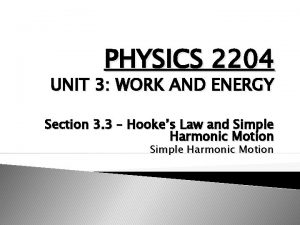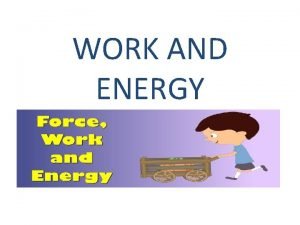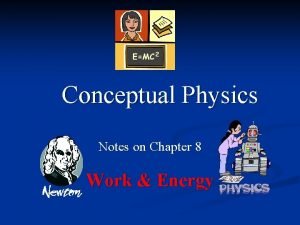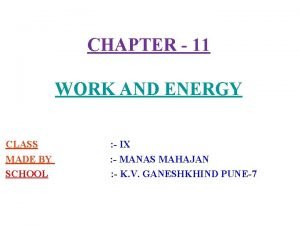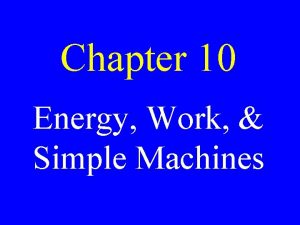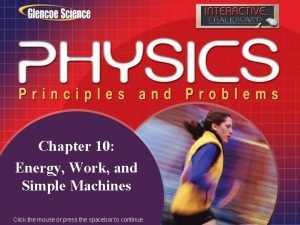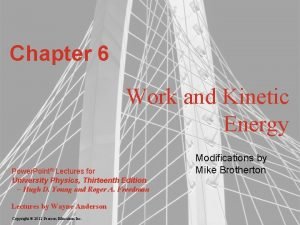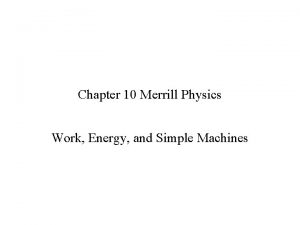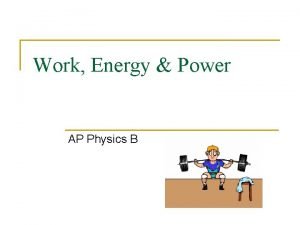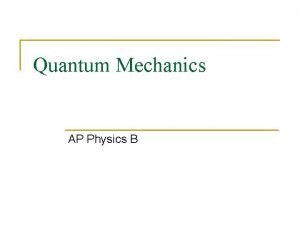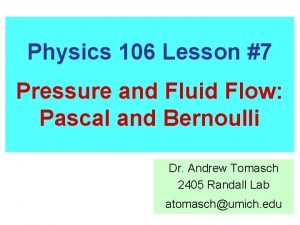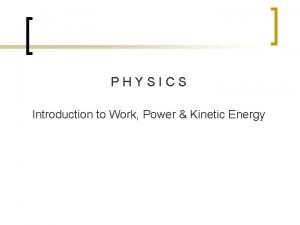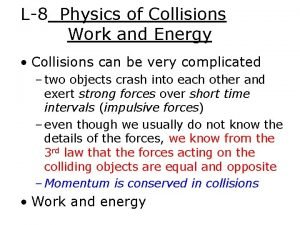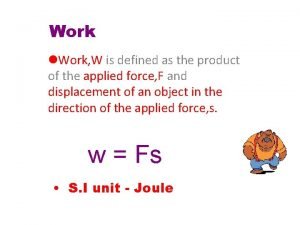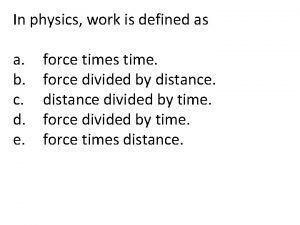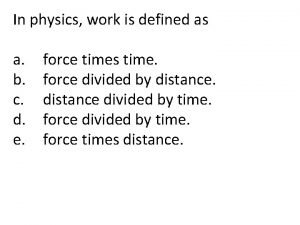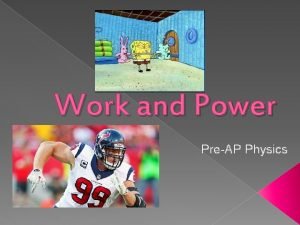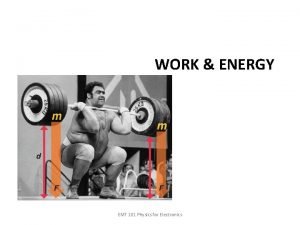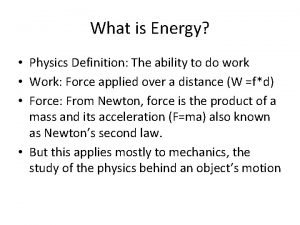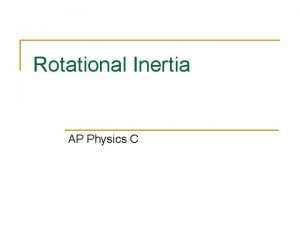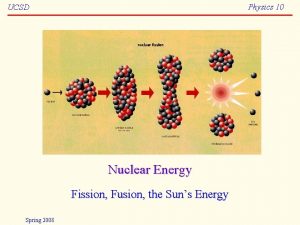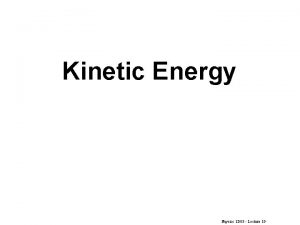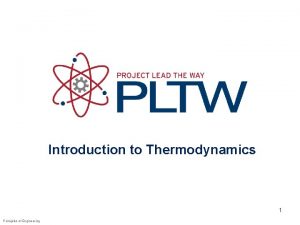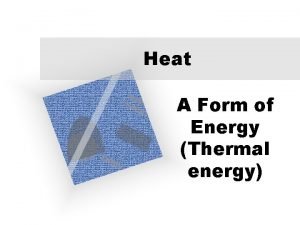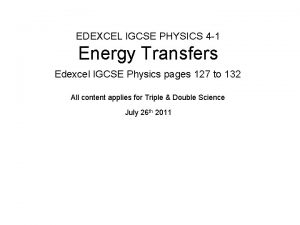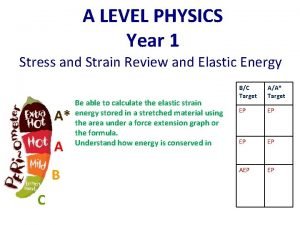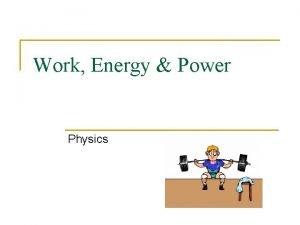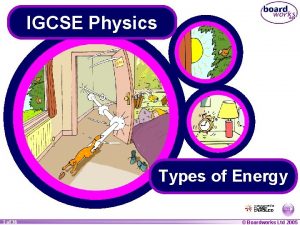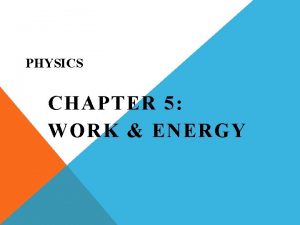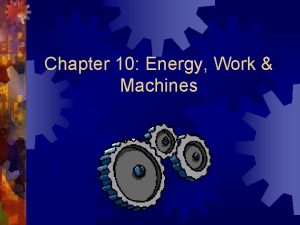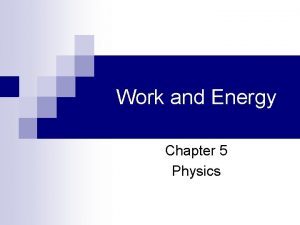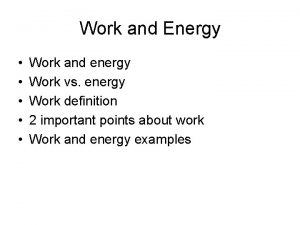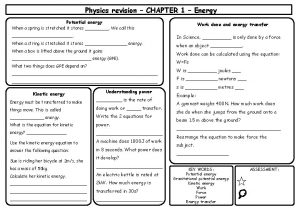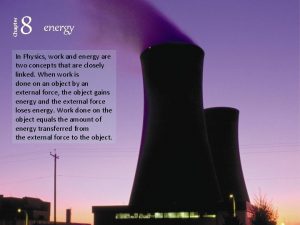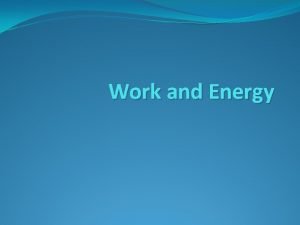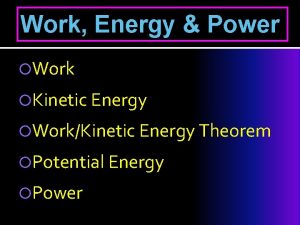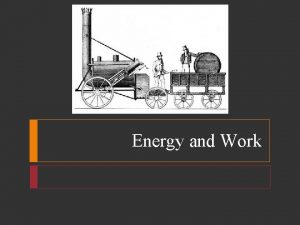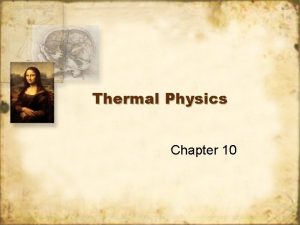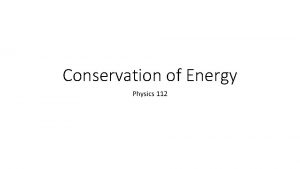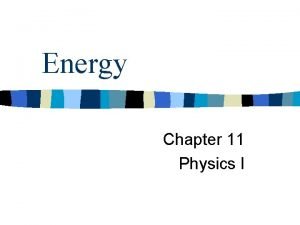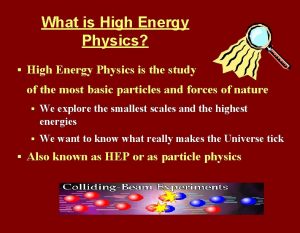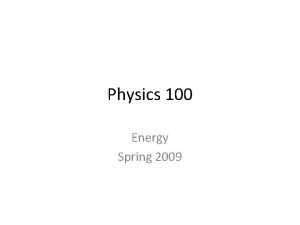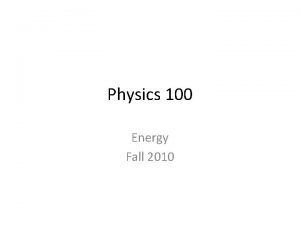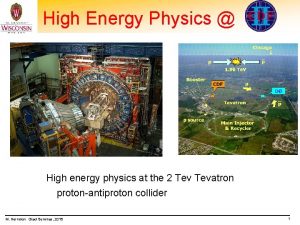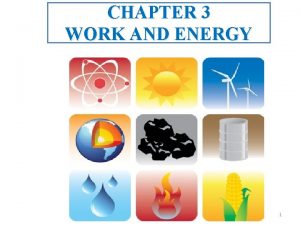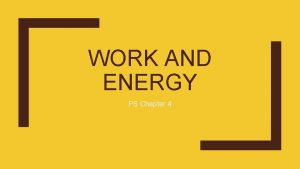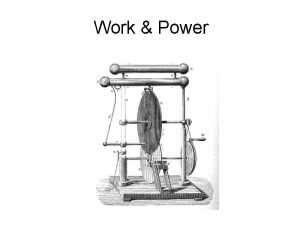WORK ENERGY Physics Chapter 5 Energy Work What
















































- Slides: 48

WORK & ENERGY Physics, Chapter 5

Energy & Work • What is a definition of energy? • Because of the association of energy with work, we begin with a discussion of work. • Work is intimately related to energy and how energy moves from one system to another or changes form.

WORK Section 5. 1

Definition of Work • In Physics, work means more than something that requires physical or mental effort • Work involves a transfer of energy • Work is done on an object when a force causes a displacement of the object • Where θ is the angle between F and d.

Caution! • Work is done only when a force or a component of a force is parallel to a displacement!

Net Work Done by a Constant Net Force F θ F cos θ d

Unit of Work • From the formula for work, determine the unit of work. • The SI unit of work is the joule (J) • The joule is the unit of energy, thus…. • Work is a type of energy transfer!!

Sample Problem A • How much work is done on a sled pulled 4. 00 m to the right by a force of 75. 0 N at an angle of 35. 0° above the horizontal?

How much work was done by Fg on the sled? How much work was done by Fup on the sled? If the force of kinetic friction was 20. 0 N, how much work was done by friction on the sled?

The Sign of Work • Work is a scalar quantity and can be positive or negative • Work is positive when the component force & displacement have the same direction • Work is negative when they have opposite directions

If the force of kinetic friction was 20. 0 N, how much work was done by friction on the sled? Wf = Fk∙d cos(180)= |-20. 0 N|∙|4. 00 m|∙(-1) = 80. 0 J Wf is negative because Fk and d have opposite directions

Is work being done on the lawnower? Why or why not? Would it be positive or negative?

Is work being done on the briefcase? Why or why not? Would it be positive or negative?

Is work being done on the briefcase? Why or why not? Would it be positive or negative?

Graphical Representation of Work • Work can be found by analyzing a plot of force and displacement • The product F∙d is the area underneath and Fd graph

Graphical Representation of Work • This is particularly useful when force is not constant (which it normally isn’t)

ENERGY Section 5. 2

Kinetic Energy • Kinetic energy is energy associated with an object in translational motion • Motion in which an object moves from one point in space to another (non-rotational) • Ek (KE) is a scalar quantity • Ek depends upon an objects mass and velocity • SI unit is the joule

Relationship of Work and Energy • Work is a transfer of energy • Net work done on an object is equal to the change in kinetic energy of the object

Proof of W-KE Theorem

Importance of W-KE Theorem • Some problems that can be solved using Newton’s Laws turn out to be very difficult in practice • Very often they are solved more simply using a different approach… • An energy approach.

Sample Problem C • A 10. 0 kg sled is pushed across a frozen pond such that its initial velocity is 2. 2 m/s. If the coefficient of kinetic friction between the sled and the ice is 0. 10, how far does the sled travel? (Only consider the sled as it is already in motion. ) FN vi Fk mg d

FN vi Fk mg d

Potential Energy • PE is “stored” energy • It has the “potential” to do work • Energy associated with an object due to its position • Gravitational PEg (or Eg) • Due to position relative to earth • Elastic PEel (or Eel) • Due to stretch or compression of a spring or elastic material

Two Types of Potential Energy Gravitational Elastic PEg = mgh PEe = ½ kx 2

Gravitational Potential Energy • Gravitational PE is energy related to position PEg = mgh • Gravitational PE is relative to a reference point • Zero PE is defined by the problem • If PEc is zero, then PEA > PEB > PEC

Hooke’s Law a) spring is unstretched b) stretched by a force F a distance x A restoring force generated by the spring –F pulls the cart back toward equilibrium c) Block exerts force -F compressing the spring a distance x A restoring force F pushes spring toward equilibrium

Hooke’s Law •

Elastic PE & Hooke’s Law • Hooke’s law is the foundation of Elastic PE • When a spring is compressed or stretched from its resting (equilibrium) position… • The work done to the spring is now stored as elastic potential energy. (Work is converted to Eelastic) • The potential energy can then do work. • Example: a toy dart gun

Elastic PE & Hooke’s Law •

Elastic PE & Hooke’s Law • PEel is the area under the Fx plot. © 1999 -2016, Rice University. Except where otherwise noted, content created on this site is licensed under a Creative Commons Attribution 4. 0 License.

Elastic Potential Energy • PE resulting from the compression or stretching of an elastic material or spring. • PEe = ½ kx 2 where… • x = distance compressed or stretched • k = spring constant Spring constant indicates resistance to stretch.

5. 3 Conservation of Energy Objectives At the end of this section you will be able to 1. 2. 3. Identify situations in which conservation of mechanical energy is valid Recognize the forms that conserved energy can take Solve problems using conservation of mechanical energy

Conserved Quantities • For conserved quantities, the total remains constant, but the form may change • Example: one dollar may be changed, but its quantity remains the same. • Example: a crystal of salt might be ground to a powder, but the mass remains the same. Mass in conserved

Conservation of Energy • First law of thermodynamics • Energy cannot be created or destroyed • Energy gained/lost by the system must be lost/gained by the surroundings • Conservation of energy in the World Series • Conservation of Energy by Dr. Baseball

Mechanical Energy • Mechanical energy is defined here as PE and KE • Is conserved in the absence of friction i. e. initial ME equals final ME • MEi = MEf • If ME = KE + PE • Then KEi + PEi = KEf + PEf • ½ mvi 2 + mghi = ½ mvf 2 + mghf

Conservation of Mechanical Energy ( A Falling Egg) Time (s) Hght (m) Spd (m/s) PE (J) KE (J) ME (J) 0. 00 1. 00 0. 74 0. 10 0. 95 0. 98 0. 70 0. 04 0. 74 0. 20 0. 80 2. 00 0. 59 0. 15 0. 74 0. 30 0. 56 2. 90 0. 41 0. 33 0. 74 0. 40 0. 22 3. 90 0. 16 0. 58 0. 74 0. 45 0. 00 4. 43 0. 00 0. 74 • As a body falls, potential energy is converted to kinetic energy • Since ME is conserved (constant)…. ΣPE + KE = ME • In the absence of friction & air resistance, this is true for mechanical devices also

Mechanical Energy • Is the sum of KE and all forms of PE in the system • ME = ΣKE + ΣPE • sigma (Σ ) indicates “the sum of”

Sample Problem 5 E • Starting from rest, a child with mass 25. 0 kg slides from a height of 3. 0 m down a frictionless slide. What is her velocity at the bottom of the slide? • Could solve using kinematic equations, but it is simpler to solve as energy conservation problem. • MEi = MEf

ME may not be conserved • In the presence of friction, mechanical energy is not conserved • Friction converts some ME into heat energy • Total energy is conserved MEi = MEf + heat

Work-Kinetic Energy Theorem Redux • The net work done on an object is equal to the change in kinetic energy of the object • Wnet = ∆KE • The work done by friction is equal to the change in mechanical energy • Wfriction = ∆ME

5. 4 Power: Pre-assessment a. Power is…. a. The application of a force b. The rate at which work is done c. The product of average speed and force b. The unit of power is the … a. Joule·sec Watt Joule/sec c&d c. The more power a motor has, the more work it can do a. True b. False d. A more powerful motor can do … a. The same work in less time b. More work in the same time c. Both are true

5. 4 Power: Objectives • In this section you will learn to • Relate the concepts of energy, time and power • Calculate power in two different ways • Explain the effect of machines on work and power • Explain the concept of kilowatt hour (k. Wh)

Power • Is the rate of work, the rate at which energy is transferred • P = W/∆t • Since W = Fd, P = Fd /∆t or • P = Fvavg • Unit of power = the watt (W) 1 W = 1 J/s 1 hp = 746 W horsepower

Sample Problem • How much power is required for a crane to lift vertically a 500. kg load at a constant speed to a height of 50. 0 m in 5. 00 sec? • P = Fd/t = mgd/t • P = (500 kg x 9. 81 m/s 2)(50. 0 m)/5. 00 s • P = 4. 91 x 104 W • P = 49. 1 k. W • How many hp is this? • 4. 91 x 104 W x 1 hp/746 W = 65. 8 hp

The role of machines in work • Machines… • Make a task easier by reducing the amount of force required to do work • Supply force needed to do work • DO NOT decrease the amount of work needed to do a task.

Purchasing Electricity: Kilowatt hour • Electrical power consumption is usually measured in kilowatt hours • The kilowatt-hour (k. Wh) is a unit of energy equivalent to one kilowatt (1 k. W) of power expended for one hour (1 h) of time • 1 kwh = (1000 W)(3600 s) = 3. 6 x 106 J = 3. 6 MJ • Electrical power is sold per k. Wh, e. g. $0. 112/k. Wh • At this rate, how much does it cost to light a 100 W light bulb for 8. 00 hours? • 0. 100 k. W x 8. 00 h x $0. 112/k. Wh = $. 0896

5. 4 Power: Post-assessment a. Power is…. a. The application of a force b. The rate at which work is done c. The product of average speed and force d. B and C b. The unit of power is the … a. Joule·sec Watt Joule/sec c&d c. The more power a motor has, the more work it can do a. True b. False d. A more powerful motor can do … a. The same work in less time b. More work in the same time c. Both are true
 Work energy theorem
Work energy theorem Section 4 review physical science
Section 4 review physical science Regents physics work power energy
Regents physics work power energy Kinetic energy formula
Kinetic energy formula Joule units
Joule units Physics 2204 unit 3: work, power, energy
Physics 2204 unit 3: work, power, energy A slingshot consists of a light leather cup
A slingshot consists of a light leather cup Work and energy
Work and energy Conceptual physics notes
Conceptual physics notes Why does it happen
Why does it happen University physics with modern physics fifteenth edition
University physics with modern physics fifteenth edition Ib physics ia examples
Ib physics ia examples Section 1 work and machines section 2 describing energy
Section 1 work and machines section 2 describing energy Energy energy transfer and general energy analysis
Energy energy transfer and general energy analysis Energy energy transfer and general energy analysis
Energy energy transfer and general energy analysis Chapter 11 work and energy
Chapter 11 work and energy Energy work and simple machines chapter 10 answers
Energy work and simple machines chapter 10 answers Chapter 10 energy, work and simple machines answer key
Chapter 10 energy, work and simple machines answer key Energy work and simple machines chapter 10 answers
Energy work and simple machines chapter 10 answers Chapter 6 work and energy powerpoint
Chapter 6 work and energy powerpoint Chapter 10 work energy and machines
Chapter 10 work energy and machines What is power
What is power Definition of work physics
Definition of work physics What is work function in physics
What is work function in physics Magnitude of buoyant force
Magnitude of buoyant force Work vs power physics
Work vs power physics Work physics definition
Work physics definition Work definition physics
Work definition physics Krinal meaning
Krinal meaning Work is defined as
Work is defined as If you lift one load up two stories how much work
If you lift one load up two stories how much work If you lift one load up two stories how much work
If you lift one load up two stories how much work Definition of work physics
Definition of work physics What is physics definition
What is physics definition Chapter 7 energy conservation of energy
Chapter 7 energy conservation of energy Energy in physics definition
Energy in physics definition What is energy in science
What is energy in science Rotational inertia ap physics c
Rotational inertia ap physics c Nuclear energy in physics
Nuclear energy in physics Energy physics definition
Energy physics definition Thermal energy equation physics
Thermal energy equation physics Formula of thermal energy
Formula of thermal energy Energy flow diagram physics
Energy flow diagram physics Strain energy formula
Strain energy formula How many types of energy
How many types of energy Energy igcse physics
Energy igcse physics Kinetic energy
Kinetic energy Define energy in physics
Define energy in physics Electric potential energy
Electric potential energy



